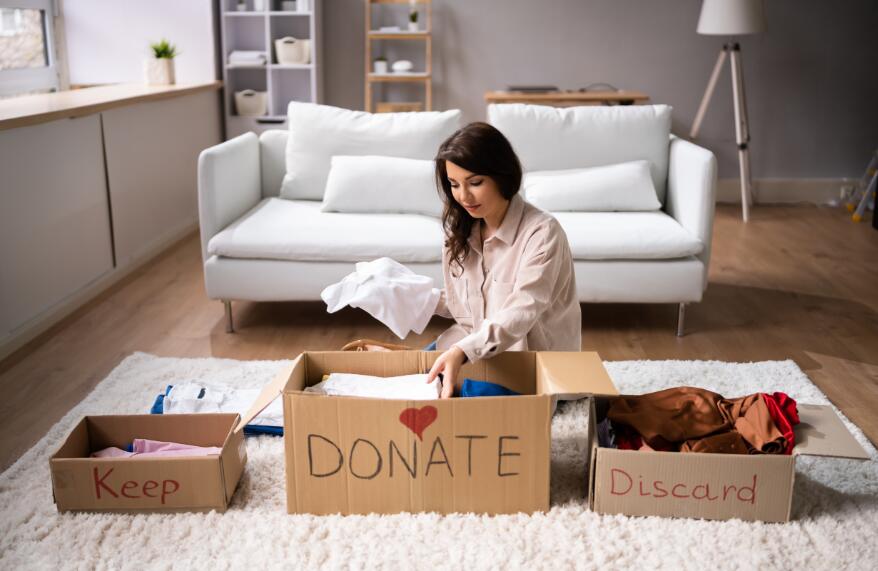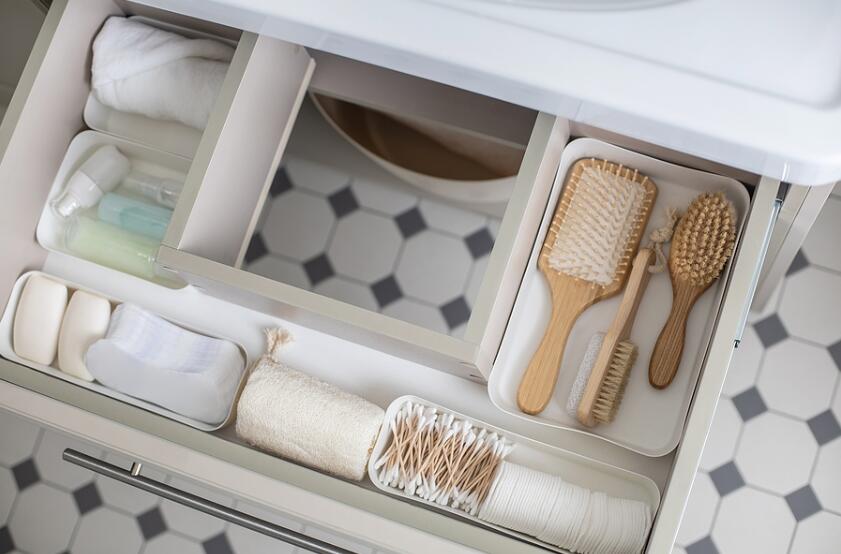1. Kitchen Organization
The kitchen is the heart of the home, and keeping it organized can make a world of difference in your cooking and meal prep experience. Here are some detailed tips and tricks for achieving a well-organized kitchen:
1.1 Organizing Kitchen Cabinets
Start by emptying out your kitchen cabinets and assessing the items you have. Get rid of any duplicates, broken utensils, or items you no longer use. Categorize your kitchen essentials into groups such as cookware, bakeware, utensils, and small appliances.
Utilize adjustable shelves to maximize vertical space. Place smaller items like spice jars and measuring cups on the top shelf, while larger pots and pans can go on the bottom. Consider using stackable bins or wire baskets to keep similar items together, making it easier to locate what you need.
1.2 Pantry and Refrigerator Organization
The pantry and refrigerator can easily become disorganized if not properly maintained. Begin by clearing out expired items and donating unopened non-perishable foods that you won’t use.
Invest in clear, airtight containers for storing dry goods such as rice, pasta, and cereals. Label each container to easily identify the contents at a glance. Arrange the items according to categories and use risers or stacking shelves to maximize space.
In the refrigerator, designate specific areas for different food groups. Keep frequently used items like milk and condiments at eye level for easy access. Utilize clear storage bins to group similar items together and prevent them from getting lost in the depths of the fridge.
1.3 Tips for Easy Accessibility
When it comes to kitchen organization, accessibility is key. Keep items that you use daily within arm’s reach to streamline your cooking process. Arrange your pots and pans near the stove, and store your most-used utensils in a countertop container or hanging rack.
Add hooks or magnetic strips to the inside of cabinet doors for storing measuring spoons, oven mitts, and other lightweight items. Install a pegboard or wall grid for hanging larger utensils like ladles and whisks.
In drawers, use dividers to separate items such as silverware, kitchen gadgets, and knives. This way, you won’t have to dig through a mess of tangled utensils when you need something specific.
2. Living Room and Entertainment Area
The living room is a space where we relax, entertain, and gather with family and friends. Maintaining an organized and clutter-free living room can greatly enhance its functionality and create a welcoming atmosphere. Here are some tips and tricks for organizing your living room and entertainment area:
2.1 Furniture Arrangement for Space Optimization
Start by assessing the layout of your living room and determine the best furniture arrangement to maximize space. Arrange seating in a conversational manner, creating designated areas for conversation and relaxation. Consider using multipurpose furniture, such as ottomans with hidden storage, to combine functionality with style.
Ensure that there is ample walking space between furniture pieces to facilitate easy movement. Avoid cluttering the room with too many pieces or oversized furniture that overpower the space. Keep in mind that a well-arranged living room will not only create a sense of spaciousness but also promote better flow and movement.
2.2 Creative Storage Solutions for Electronics and Media
In today’s digital age, the living room is often filled with electronics and media devices. To keep these items organized and easily accessible, invest in storage solutions such as TV stands with built-in shelving or entertainment centers with designated compartments for devices like game consoles and DVD players.
Use cable management systems to prevent tangled cords and create a neater appearance. Consider using decorative boxes or baskets to store remote controls, DVDs, and other media accessories. This not only keeps them close at hand but also adds a stylish touch to your living room decor.
2.3 Maintaining a Designated Entertainment Space
Designate a specific area in your living room for entertainment purposes. This could be a media console, a bookshelf with your favorite reads, or a gaming station. Keep this space organized by regularly decluttering and organizing the items that belong there.
Store board games, puzzles, or video game accessories in labeled bins or baskets. Arrange books by category or color on the bookshelf for an inviting and organized look. By maintaining a dedicated entertainment space, you can easily find and enjoy your favorite entertainment options without having them scattered throughout the room.
3. Bedroom Organization
Your bedroom should be a haven of relaxation and tranquility, free from clutter and chaos. A well-organized bedroom can contribute to better sleep, increased productivity, and a sense of calm. Use these tips to transform your bedroom into a serene and organized space:
3.1 Streamlining Your Clothing Storage
Start by decluttering your wardrobe. Remove any clothes that no longer fit, are damaged, or that you haven’t worn in over a year. Consider donating them to charity or selling them online. Organize your remaining clothes by category, such as tops, bottoms, dresses, and jackets.
Invest in closet organizers, such as hanging shelves or storage bins, to make the most of your closet space. Use matching hangers to create a cohesive and visually appealing look. Fold and stack your clothes in drawers or on shelves, organizing them by type and color for easy access.
3.2 Creating a Relaxing Bedside Setup
Your bedside table is a crucial element in bedroom organization. Use it to store essential items that you need within reach, such as a lamp, alarm clock, or a book. Consider using a bedside caddy or small storage containers to keep items like earphones, reading glasses, or a journal neatly organized.
Minimize clutter by incorporating hidden storage options, like a nightstand with drawers or shelves. Keep the surface clutter-free by limiting the number of items you display. A simple vase of fresh flowers or a scented candle can add a touch of beauty and relaxation to your bedside setup.
3.3 Maximizing Closet and Drawer Space
If you have limited closet space, make the most of it by using space-saving tools like hanging shoe racks, cascading hangers, or fabric storage boxes. Optimize your drawer space by using drawer dividers or organizers to separate items like socks, underwear, and accessories.
When organizing your closet, consider the frequency of use for each item. Keep everyday essentials at eye level or within easy reach, and store seasonal or less frequently used items in higher or lower spaces. Utilize under-bed storage containers for items like extra linens or out-of-season clothing.
4. Home Office Organization
A well-organized home office is essential for productivity and focus. Whether you have a dedicated room or a small workspace, keeping your home office organized can help you stay on top of tasks and maintain a clear mind. Here are some tips to achieve a clutter-free and efficient home office:
4.1 Decluttering and Sorting Paperwork
Start by going through your paperwork and organizing it into categories such as bills, important documents, and reference materials. Dispose of any unnecessary documents and create a filing system for the ones you need to keep.
Invest in a filing cabinet or file storage boxes to keep your documents organized and easily accessible. Label each folder or box clearly, making it simple to find what you need when you need it. Digitize important documents whenever possible to reduce paper clutter.
4.2 Optimal Desk Setup
Create an efficient and organized desk setup. Keep only essential items on your desk, such as your computer, keyboard, and frequently used office supplies. Use desk organizers, such as pen holders, desk trays, and cable management systems, to keep everything tidy and within reach.
Consider using a desktop or wall-mounted file organizer for keeping active files and projects easily accessible. Have a designated spot for incoming and outgoing mail to avoid it piling up on your desk.
4.3 Utilizing Storage Solutions
Maximize storage space in your home office with shelves, cabinets, or storage bins. Use them to store books, reference materials, and other supplies. Utilize vertical space by installing wall-mounted shelves or pegboards for storing items like books, files, or office decor.
Label storage containers to quickly find what you need. Clear plastic bins or stackable baskets can be useful for storing and categorizing office supplies, cords, and technology accessories.
4.4 Tidy Digital Workspace
Don’t forget to declutter your digital workspace as well. Organize files and folders on your computer, deleting or archiving anything you no longer need. Use cloud storage or external hard drives for backup and easy access to documents and files.
Organize your email inbox by creating folders and setting up filters to automatically sort incoming messages. Regularly delete unnecessary emails and keep your inbox streamlined and clutter-free.
5. Bathroom Organization
An organized bathroom not only creates a calming environment but also makes it easier to find and utilize your everyday essentials. Follow these tips to keep your bathroom clutter-free and functional:
5.1 Clearing Clutter and Purging Unused Items
Start by decluttering your bathroom cabinets, drawers, and countertops. Dispose of expired products, empty containers, and items you no longer use. Be honest with yourself about what you truly need and use on a regular basis.
Organize your remaining items into categories such as skincare, haircare, and hygiene products. Consider donating unopened or gently used beauty products to minimize waste.
5.2 Efficient Vanity and Drawer Organization
Utilize drawer dividers or small baskets to separate and organize items like makeup, hair accessories, and personal care products. This will help prevent items from getting jumbled together and make it easier to find what you need.
Invest in vanity organizers, such as tiered trays or storage caddies, to keep frequently used items within reach. Use canisters or jars to store cotton balls, Q-tips, and other small bathroom essentials. Label containers to easily identify their contents.
5.3 Maximizing Storage Space
Making the most of storage space is essential in a bathroom. Install shelves or wall-mounted cabinets above the toilet or sink to store towels, toiletries, or extra supplies. Utilize the back of the bathroom door with hooks or an over-the-door organizer for hanging towels or robes.
Use a shower caddy or hanging mesh organizer to keep shower essentials organized and easily accessible. Consider using small storage baskets or bins under the sink to corral cleaning supplies and extra toiletries.
5.4 Regular Maintenance and Cleaning
To maintain an organized bathroom, establish a routine of regular cleaning and decluttering. Wipe down countertops, mirrors, and surfaces regularly to prevent dust and grime buildup. Dispose of empty containers or expired products promptly.
Take a few minutes each week to assess the organization of your bathroom and make any necessary adjustments. This will help you stay on top of clutter and ensure that everything has its designated place.
6. Dining Room Organization
An organized dining room not only facilitates efficient meal preparation but also creates a welcoming space for family and friends. Use these tips to optimize your kitchen’s functionality and keep it neat and tidy:
6.1 Clearing Countertop Clutter
Start by decluttering your countertops and keeping only the essentials within reach. Store small appliances that you don’t use daily in cabinets or designated storage areas. Consider installing a pot rack or wall-mounted hooks for hanging frequently used cookware.
Keep everyday items like cutting boards, utensils, and spices close at hand. Use countertop organizers, such as a utensil holder or spice rack, to keep these items organized and easily accessible.
6.2 Efficient Cabinet and Pantry Storage
Organize your cabinets and pantry by grouping similar items together. Consider using stackable storage containers or bins to maximize vertical space and keep items like canned goods, snacks, or dry ingredients neatly organized.
Utilize organizers such as shelf risers or sliding cabinet baskets to make the most of cabinet space. Label containers to quickly find what you need, and regularly check for expired food items to reduce clutter.
6.3 Creating Functional Drawer Space
Organize your kitchen drawers based on functionality. Use dividers or trays to separate and organize utensils, cooking tools, and small gadgets. Store frequently used items towards the front of the drawer for easy access.
Consider adding drawer liners or nonslip mats to keep items in place and protect the drawer surface. Label or color-code drawers to help family members or guests quickly find what they’re looking for.
6.4 Smart Refrigerator and Freezer Organization
Maximize the usability of your refrigerator and freezer by organizing food items efficiently. Keep like items together and designate specific areas for fruits, vegetables, dairy, and meat.
Use clear storage containers or bins to group similar items together and make them more accessible. Label containers with the contents and date for easy identification. Regularly clean out expired or spoiled food to maintain a clean and organized refrigerator.
By implementing these kitchen organization tips, you can create an inviting and functional space that enhances your cooking experience.
Conclusion
In conclusion, organizing your home is a worthwhile endeavor that brings numerous benefits. By decluttering, grouping similar items, utilizing storage solutions, and maintaining regular tidiness, you can create a visually appealing and functional space. Remember to label containers, consider sustainability, and adapt these tips to suit your needs. An organized home promotes calm, productivity, and a balanced lifestyle.



